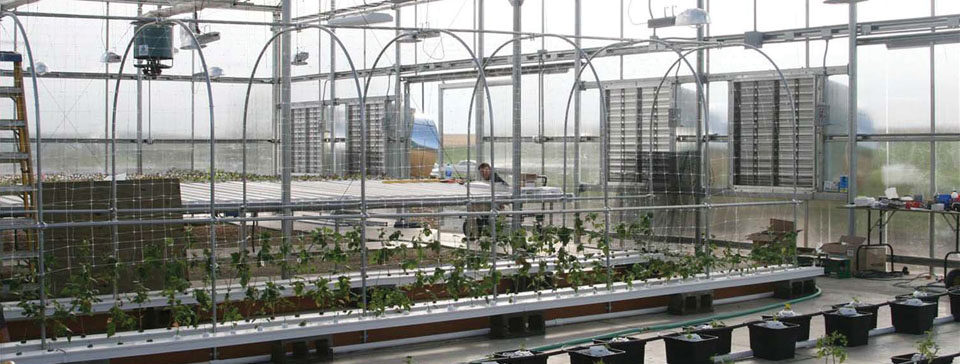LED Greenhouse Lights: Looking at LED Lighting for Greenhouse Production
August 1, 2017
Efficient lighting is one of the most effective ways to create a successful indoor or greenhouse crop. The ideal lighting utilizes the necessary color spectrum for optimizing the grow cycle, has a low-temperature and is energy-efficient. The most innovative lights are designed to optimize photosynthesis and improve upon physiological functions, and LEDs are leading the way in the lighting revolution.
LED Lighting
LED stands for Light Emitting Diode. The lighting industry has largely been driven by the potential energy savings achieved by utilizing LED lighting, a claim supported by the major increase of LEDs on the market, their rate of technological development over recent years and their improved energy efficiency.
The Department of Energy claims that declining costs of LEDs make them more appealing and adoptable. According to their predictions, by 2030, LED lighting is projected to reach 84 percent of lumen-hours sales in the lighting market.
LED lighting has an unprecedented potential to develop into an incredibly energy efficient greenhouse technology, partially because of its ability to produce high-quality white light. Improving manufacturing, illumination, light distribution, color quality and building integration are all ways LEDs have managed to evolve so quickly over the last decade.
Compact designs help address building integration, while manufacturing resilient fixtures results in a long-life. These features, combined with the ability to dim LEDs or use sensors, set these lights apart from traditional incandescent lamps. Such improvements have made LED products more affordable and accommodating to grow operations, which has led to LEDs being more prevalent in the marketplace.
Savings
The Department of Energy largely agrees that LEDs provide remarkably energy efficient technology, which has the potential to fundamentally change the future of lighting. Energy Star rated Residential LEDs use at least 75% less energy, and last 25 times longer than traditional incandescent lighting. Within a decade, it is projected that the adoption of LED lighting could save domestic consumers and businesses $20 billion a year in electrical costs.
LEDs help growers save money in many notable ways. Since they are generally thinner and cooler, they can be hung closer to the ceiling, which gives grows more room than traditional grow light systems. LEDs are small and can be used individually or in combination with others.
The small size and low profile of LEDs allow them to be used in spaces that are too tight for other light bulbs to fit. Because LEDs emit light in a specific direction, they are more efficient than incandescent and fluorescent lights, which waste energy by emitting beams in all directions, dispersing and minimizing luminosity.
Initial costs of LED’s can be higher than traditional grow lights, though LEDs cost significantly less to run and therefore result in remarkable savings. Best of all, these light sources minimize a grower’s carbon footprint drastically. If adopted as the norm over the next decade, LED lighting can lower domestic CO2 emissions by around 100 million metric tons, per year.
Sign up now to learn more
Temperature
One major benefit of using LEDs is that they don’t produce heat in the form of infrared radiation, like traditional bulbs. Conventional light bulbs actually waste most of their energy as heat.
While conventional bulbs can give off as much as 90 percent of energy as heat, LEDs remain cool as a cucumber. The absence of this excessive heat allows LED fixtures to be set up in locations where conventional lights may burn plants.
LEDs produce less heat because fewer watts are being consumed than with traditional bulbs. In fact, traditional HPS lights convert over half of their watts into infrared heat. The lower lamp temperature means a cooler grow room.
Being able to save on extra fans can help out electrical costs. LEDs consume a significantly lower amount of power and energy, which helps generate remarkable savings.
Optimizes Growth
Full spectrum LED Grow Lights are the most accurate on the market. The best source of ideal light in horticultural endeavors is always the sun.
Plants have evolved over millennia to draw energy from natural light cycles, in order to allow for photosynthesis, or the conversion of CO2 and H2O into sugars for growth. By utilizing different color spectral lighting, full spectrum LED technology creates the ideal light fixture that mimics the changes in daylight throughout the plant’s life cycle, triggering different life processes.
For example, Chlorophyll A and Chlorophyll B are both vital forms of chlorophyll for successful photosynthesis. But, Chlorophyll A absorbs primarily red light, while Chlorophyll B primarily absorbs blue light. Full spectrum lights are also adjustable, allowing growers to obtain their ideal greenhouse lighting strategy and improve plant growth.
Pro Tip
LEDs can mask many growing problems or deficiencies, so examine plants with a white light regularly, at least once a week. It can take a matter of hours for a pest or nutrient issue to do irreparable damage to a crop, and much longer to rid your grow space of the problem.
Browse through GrowSpan’s line of grow lights and accessories, including light meters, bulbs, wet location fixtures and ballasts. Install innovative lighting today to grow all year long and improve crop production with total lighting control.
To take advantage of LED Greenhouse Lights for your operation, call or REQUEST A QUOTE today.

